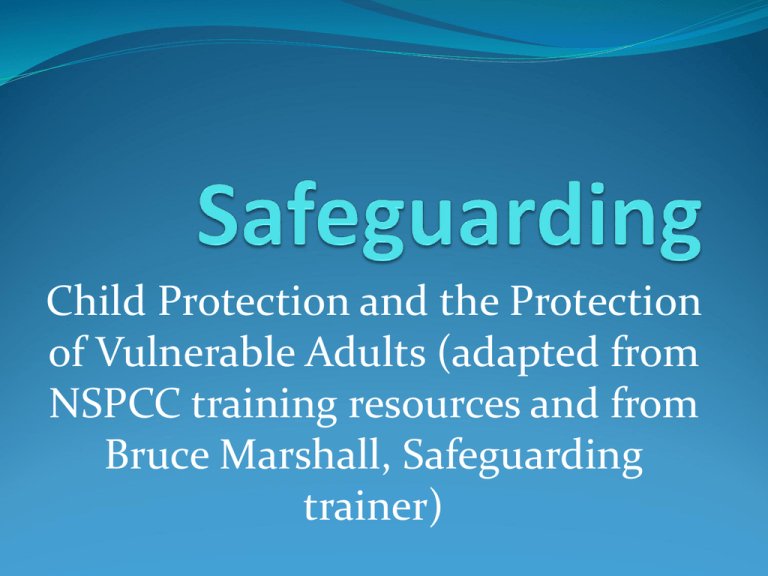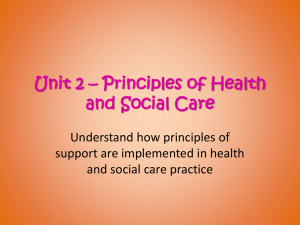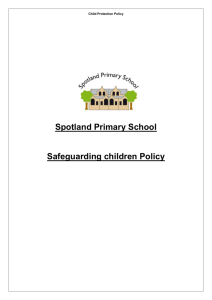Safeguarding - Harrow College
advertisement

Child Protection and the Protection of Vulnerable Adults (adapted from NSPCC training resources and from Bruce Marshall, Safeguarding trainer) What you will learn The essentials in safeguarding and child protection To distinguish between the terms safeguarding and child protection To identify and describe the categories of abuse and neglect and some indicators of them To describe your responsibility as a teacher in relation to safeguarding and child protection To outline the role of other professionals in the process The importance of recording appropriate concerns and managing disclosure and confidentiality To become more aware of protecting children in a digital age Quiz In pairs – discuss and fill in the “Child Protection and Safeguarding Awareness” quiz In the same pairs, discuss and fill in the “Judgements on Behaviour” quiz Outline of today’s session Every Child Matters Child Protection and Safeguarding Types of harm and abuse Disclosure, sharing, recording and referrals Responsibilities On-line safety Be Healthy Achieve Economic Wellbeing Stay Safe Every Learner (Child) Matters 2004 Make a Positive Contribution Enjoy and Achieve In groups Define Child Protection Define Safeguarding Child Protection Part of safeguarding and promoting welfare Activity undertaken to protect specific children suffering, or at risk of suffering, significant harm Local Authorities have a legal duty (Children Act 1989) to investigate We have a responsibility to work in partnership to safeguard and protect children and vulnerable adults. Safeguarding Safeguarding is a relatively new term which is broader than ‘child protection’ as it also includes prevention Safeguarding children and young people covers: protecting them from maltreatment preventing impairment of health or development ensuring they are safe and cared for in school or FE college (or other setting) enabling them to have best life chances and enter adulthood successfully In your group Discuss and record on a flip chart, three policies, procedures or practices that your organisation has in place to help ensure the safeguarding of your learners Safeguarding – Our Responsibilities We all share a responsibility to: Provide a safe environment for learning Identify those suffering or likely to suffer significant harm and take appropriate action Prevent unsuitable people from working with young people and vulnerable adults (vetting and barring) Safeguarding – Our Responsibilities cont. Promote safe practice and challenge poor or unsafe practice Identify grounds for concern and take appropriate action Contribute to effective partnership working with those involved in providing services to young people and vulnerable adults Develop appropriate skills Abuse Categories In your group, think of the 4 categories of abuse and give 2 -3 examples of the type of abuse that could happen under each category Physical Abuse Physical abuse may involve hitting, shaking, throwing, poisoning, burning or scalding, drowning, suffocating or causing physical harm to a child or vulnerable adult (Working Together to Safeguard Children 2010) Physical Abuse What might lead to concern about deliberate injury?: Where on the body is the injury? What sort of injury is it? What does the injury look like? What does the child and/or the parent say about the injury? How often is there an injury? Behaviour of the child/parent – does the child behave like a child with an accidental injury? (What is that like?) Emotional Abuse Emotional abuse is the persistent emotional maltreatment of a child such as to cause severe and persistent adverse effects on the child’s emotional development • It may involve conveying to children that they are worthless or unloved, inadequate, or valued only insofar as they meet the needs of another person. • It may include not giving the child opportunities to express their views, deliberately silencing them or ‘making fun’ of what they say or how they communicate. (Working Together to Safeguard Children 2010) Emotional Abuse Emotional abuse is difficult to: ◦ Define, identify and/or recognise, prove (if in doubt …) Key features: ◦ chronic and cumulative ◦ long-term impact ◦ all abuse and neglect have emotional effects ◦ children can be harmed by witnessing abuse Examples of abusive behaviour felt by children ◦ ignored ◦ put down/belittled ◦ shouted at ◦ terrorised ◦ told they are useless, stupid, wicked, unlovable, clumsy, unattractive, weak, thick Sexual abuse Sexual abuse involves forcing or enticing a child or young person to take part in sexual activities, not necessarily involving a high level of violence, whether or not the child is aware of what is happening. The activities may involve physical contact, including assault by penetration (for example, rape or oral sex) or non-penetrative acts such as masturbation, kissing, rubbing and touching outside of clothing. They may also include noncontact activities, such as involving children in looking at, or in the production of, sexual images, watching sexual activities, encouraging children to behave in sexually inappropriate ways, or grooming a child in preparation for abuse (including via the internet). Sexual abuse is not solely perpetrated by adult males. Women can also commit acts of sexual abuse, as can other children. (Working Together to Safeguard Children 2010) Sexual abuse Usually planned and systematic Can involve: ◦ grooming the child ◦ grooming the child’s environment ◦ relatives ◦ family friends ◦ neighbours ◦ babysitters ◦ people working with the child in school, faith settings, clubs or activities. Slide 18 Neglect A lack of parental care Poverty, lack of information and lack of service provision can contribute More children registered to category of neglect than any other category Can include parents or carers failing to: ◦ provide adequate food, clothing and shelter ◦ protect a child from physical and emotional harm or danger ◦ ensure adequate supervision or stimulation ◦ ensure access to appropriate medical care or treatment (Working Together to Safeguard Children March 2010) Safeguarding – understanding the role of others & sharing information Social, Family and Community Support Housing, social care and children’s services Child and Adult Mental Health Services Police and justice system Probation, Youth Offending Team Primary Care Trusts and National Health Services General Practitioners Hospitals including Accident and Emergency Schools – leaders, teachers and support staff Connexions Personal Advisers Progression information Case study In your group discuss the case study and write down your strategies to deal with the situation Allegations against staff Listen Explain that you will not be able to maintain strict confidentiality and why Record Refer (preferably with the student) Maintain strict confidentiality except to report Protect yourself Don’t put yourself at risk Follow your organisation’s procedures Disclosure What, Who, When and Where? Managing Disclosure Listen Assess whether at risk of harm Don’t be judgemental Don’t interview or prompt Don’t promise confidentiality, advise that you will inform and consult Reassure Keep accurate notes Making a decision to refer A Concern Record and Share Risk of Significant Harm Involves allegation of abuse Safeguarding Officer to Refer Not a risk of significant harm Consult and monitor Note:You should refer directly if you think you are being blocked by other staff Anonymous Provides voice amplification Always on On-line World Active not passive Addictive Global Away from Supervision Test For each of the statements that appear on the next slide, Give yourself 10 points (and no more than 10) for any statement that applies to you Keep a running total (mental arithmetic – no need to write down your score) Remember your total score Time allowed – 45 Seconds 10 Points for each statement that applies to you Frequently use a mobile phone Receive email on handheld device Member of social networking site (e.g. Facebook, Hi 5) Own and use a Wii or games console (your own) Watched a video on YouTube Uploaded a video to YouTube Appeared in a YouTube video Played a game on the internet Have your own Blog Played a networked game on the internet with people in another country Uploaded photos to the internet Use Skype to talk to contacts abroad Frequently shop online Have your own personal web site Use a laptop with a wireless internet connection Use twitter Own an i-pad What’s your score? Up to 40 – Digital immigrant with a lot to learn 50-90 – Speaking digital but with an accent 100-130- Almost fluent in digital 140-160- Probably a digital native When used in school sixth form: Average student score – 120 Average teacher score - 50 Quiz about the online world Individually answer the questions on the quiz Internet and mobile safety Note: ◦ We have a duty of care to avoid causing harm ◦ 33% of children have received sexual or nasty comments on-line ◦ 7% of parents believe their kids have received such communications Main fears reported by children ◦ Peers (cyber-bullying) and security ◦ Knowing how to manage safety ◦ Plagiarism and identity theft ◦ Understanding privacy settings On-line protection Digital divide or generational divide? Technology not the issue – behaviour is Not e-crime but abuse ◦ Old problem, new environment Cyber-bullying is bullying Education and training is a key part of solution ◦ Understanding the differences between face to face communication and on-line communication ◦ Understanding and managing risk. What have you learnt today? Write on your whiteboard 4 main points of what you have learnt today Homework - find out about your organisation’s Safeguarding policies Key Messages Child Protection – all young people under 18 (and vulnerable adults) Risk and responsibility Manage disclosure Confidentiality Referral Child Protection Team Protect yourself and maintain professional boundaries If in doubt … Pick up the ‘phone






